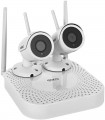Connection
The standard way to connect cameras, provided in the video surveillance kit.
-
Wired. This type of connection requires wiring from each camera, which is not very convenient. At the same time, wired devices are simple, reliable and much cheaper than wireless ones, cameras can receive the power needed for operation via the same wires (see "POE power"), and for an analogue connection (see "Type") this is generally the only available option. Due to this, the vast majority of modern surveillance systems use a wired connection.
-
Wireless. Wireless connection, usually via Wi-Fi. This option greatly simplifies the installation of cameras, because. the user is relieved of the need to lay wires to the registrar. On the other hand, wireless equipment is not cheap, and the cameras will still need to be connected to power sources (or use their own batteries, which will have to be monitored). Therefore, this option has not received much distribution, it is designed mainly for those cases where the ability to do without extra wires is decisive.
Video channels
The number of video channels that the set's recorder is capable of simultaneously processing. In fact, this is the number of cameras that the device can simultaneously work with; it is technically possible to connect more cameras, but this will require additional equipment — such as quadrators.
The choice for this parameter depends on how extensive and extensive the observation system is planned to be built. At the same time, it should be noted that modern technologies allow combining several registrars into a system with a single control; therefore, for numerous cameras, it is sometimes easier to purchase several relatively modest kits than one multi-channel one.
Camera model
A model of pointed cameras supplied with a video surveillance kit. Knowing this data, you can find detailed information on the cameras and clarify their characteristics. Also, if you buy additional cameras of the same model, you don't have to worry about compatibility.
Matrix size
The physical size of the sensor in the pointed cameras is diagonally, in inches (fractions of an inch).
The larger the sensor, the less prone it is to noise, the better image quality it can provide, and the better it is suited to low light conditions. This is due to the fact that each individual pixel gets more light, because. on a large matrix and individual dots are larger. On the other hand, large matrices are more expensive.
Number of megapixels
Sensor resolution of pointed cameras in megapixels (millions of pixels).
Higher resolution allows you to get a more detailed "picture". However, increasing the number of megapixels without increasing the sensor size can result in poor overall image quality and noise, especially in low light. Therefore, in itself, the high resolution of the matrix does not guarantee high quality shooting.
Horizontal viewing angle
The viewing angle of the directional cameras supplied as standard is horizontal.
Wide viewing angles allow you to cover a large area; this is especially important given that directional cameras are often made stationary. On the other hand, all other things being equal, a larger viewing angle will mean a lower degree of magnification - objects will look smaller, detail will be worse. Therefore, when choosing according to this parameter, you should proceed from what is more important - a wide field of view or “range”.
Illumination range
The range of infrared illumination provided in the standard pointed cameras of the kit.
IR illumination allows the camera to shoot in low light conditions (up to complete darkness); at the same time, for a number of reasons, it is preferable to classical backlighting in the visible range. The backlight range is the approximate distance from the camera to the object at which it (in total darkness) will be normally visible in the frame. Note that actual visibility may vary greatly depending on the size, colour and reflectivity of specific items; Nevertheless, the claimed backlight range allows you to fairly accurately assess the "night" characteristics of the camera.
PoE power
Ability to power IP cameras from the registrar, using
PoE technology.
This technology (Power over Ethernet) allows you to supply power to external network devices over a LAN cable. Simply put, each camera will be able to receive power through the same wire through which it transmits the video signal to the recorder. This eliminates the hassle of separate power supplies. For PoE to work, it must be supported by both the recorder and the cameras; however, this is what is usually provided for in video surveillance kits.
LAN (RJ-45)
The number of
LAN connectors (RJ-45) provided in the design of the complete registrar.
Such connectors are commonly used for wired connections in computer networks; their number and the purpose of these connectors directly depends on the type of kit (see above). So, in analogue models, there is usually only one LAN port, it is designed to connect the recorder to a local computer network (or a router in order to make the device accessible via the Internet). In digital and hybrid recorders, the number of LAN ports corresponds to the number of digital video channels, they play the role of inputs for IP cameras; and the connector for connecting the registrar itself to the network is usually designated as WAN and is indicated separately.

